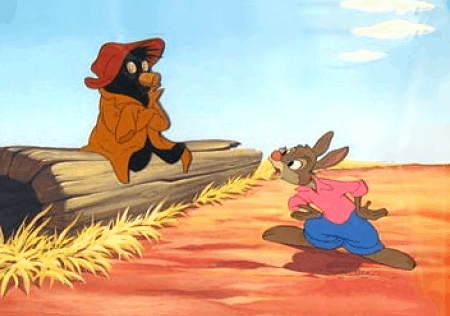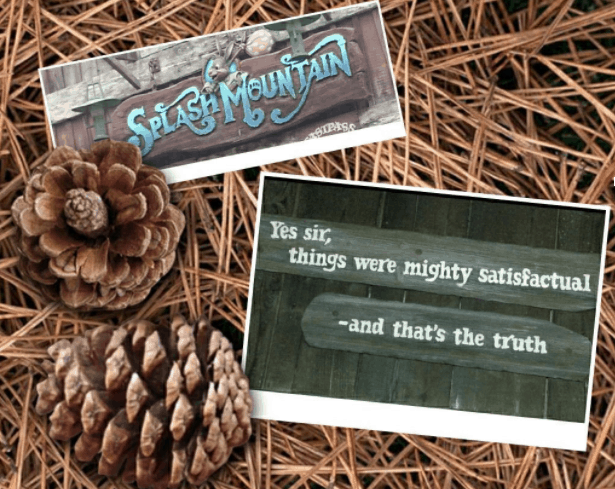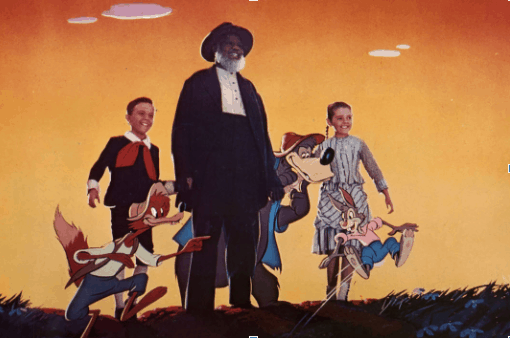Do you know what movie the iconic song “Zip-A-Dee-Doo-Dah” is from? Or what movie Disneyland’s Splash Mountain is based on? If you answered no, Disney has succeeded in hiding its most offensive film, Song of the South.
Song of the South is set on a southern plantation during the Reconstruction Period after the Civil War, although this tidbit isn’t overtly stated. This 1946 film depicts African Americans working at the service of the white wealthy plantation owners. While they are slaves no longer, their “happy” service greatly downplays their less than pleasant situation as they appear still perfectly content with life on a plantation. One is left to assume that the emancipation of slaves magically healed the master/slave relationship. The viewer can conclude that the horrors of slavery were erased from everyone’s memory – including the former slaves.
But we know the truth: No amount of Disney Magic can fix that.
Perhaps Disney sees this as they have chosen to keep this film locked away in its vault in the United States. But why has Disney deemed this movie “socially unacceptable” for us but perfectly fine to be sold abroad? Should a “socially unacceptable” movie have an attraction based on it as Splash Mountain is essentially a monument to this film?

Disneyland’s Splash Mountain: A monument to a racist film?
I first saw this movie when I was 8 years old and my grandma procured a copy from abroad and had it converted to VHS. Though too young to fully realize how this film could be construed as offensive, I did pick up on the fact that the black people seemed inferior as they were talked down to and bossed around.
Knowing how even children can sense the racial disparity in the film, recent Disney Legends Award honoree Whoopi Goldberg wants to dialogue about this movie in the hopes of bringing it back to the public. I, for one, am in agreement.
Not acknowledging the prejudices that were commonplace in the past ignores the fact that these stereotypes ever happened. As humans we continually grow and change. So do our social consciousnesses. In learning from our mistakes we can learn how to avoid them in the future. It is easy to dismiss tasteless humor and stereotypes as a product of the past, but is that enough?
On the one hand, the animated sequences of this film are beautiful and the film unfolds in a quintessential Disney storytelling way. It’s a story about Uncle Remus, a storytelling man, who children look up to, listen to and learn from. Uncle Remus conveys hard truth to help Johnny to cope, grow and learn about real life. In this way, Uncle Remus acts as a wise figure and true adult role model, guiding Johnny. I’m willing to bet that Uncle Walt saw a bit of himself in him – one who teaches children to find good adult role models, look past race, and make friends.
But if these were to be animated today, the dialect in which the Br’er Rabbit, Br’er Bear, and Br’er Fox speak would need to be rethought. The term “tar baby“ must be omitted. The take-away points of the stories would be changed to be inclusive, not simply directed at the service of Johnny’s problems. For example, the first lesson Uncle Remus teaches Johnny through a tale is that “You can’t run away from your trouble’s. Thar ain’t no place that far.” This might be a fitting lesson for a rich white boy, but does it send a message of complacency for those who were once enslaved?
Let’s face it – no one wants to talk about slavery. This is the ugliest, most embarrassing and painful chapter of our history. And in a happy Disney film, who would want to treat this downer? While Disney’s intent is to entertain, it never really does concern itself with accurately portraying history. But ignoring the horror of slavery is not really owning that it was wrong in the first place. It’s less painful to look the other way. The film suggests that not talking about it is the way to go. Uncle Remus spends a lot of time reminiscing and teaching Johnny through stories, but the character omits any recollection of slavery.

Br’er Rabbit and the “Tar Baby”
For a film that doesn’t acknowledge slavery, it has no problem accepting that black people have a servant’s role on a plantation. When Johnny first arrives on the plantation, he is assigned an “ill-kempt but good natured” (the movie’s words) black boy to look after him. As an 8 year old, this was strange to me: it would be as if I went to visit my grandmother and she told the boy next door to look after me. Consequently, this film told me something about how the wealthy white folk could control the black population. Furthermore, Johnny’s grandmother who runs the plantation refers to to Uncle Remus as a “meddling old rascal.”
Another clear lesson Uncle Walt hopes to impart on us is that we ought to look past class when we make friends. Johnny befriends Jenny who lives in a shack on the edge of the plantation with her mom and two brothers who bully her. Johnny’s mother doesn’t like the idea of him having this lower class friend, and even tries to dissuade him from inviting her to his birthday party. Jenny and Johnny don’t seem to notice that they are from different worlds. Does highlighting the difference in classes try to ignore the racial issues?
***
The theme that wins out for me is how friendship is found among unlikely people despite the difference that would seek to divide. Whether your friend is an older black man or a poor girl from the lower class, deep within us is a kinship that would rather see unity that division. Sure this is a Disney film where happily ever afters reign supreme. But maybe Song of the South does give us a real insight as to how the world could be, in spite of all its troubles: a world where you choose not to subscribe to social and economic structures that promote disunity.
So what’s good about this movie? Why should we want to see it finally come out of Vault Disney?
- It’s the first color film shot by famed cinematographer, Gregg Toland, who shot such masterpieces as The Grapes of Wrath and Citizen Kane.
- It was the first Disney movie to have an African American in a lead role, who incidentally went on to win an honorary Academy Award for his performance.
- Walt Disney Animation perfected its technique of mixing live action with animation.
- And let’s not forget that iconic song which also won an Oscar.
Aside from the films accolades, the core of the story tells us universal truths that people of all ages, colors and class can relate to – that we can envision a world of unity. This is a magnificent, albeit flawed, piece of art.
That being said, for a re-release to be in order, there must be mutual sensitivity on all sides. We all need to recognize the way African Americans are portrayed on the plantation. However unintentional it may be, it is in fact offensive to our black brothers and sisters. Not admitting this most certainly downplays the horrible experience of Reconstruction America for African Americans. Art does reflect current understandings of life. As unfortunate as it is, this Disney film was no exception. Acknowledging the mistakes is a heroic and honest, and this is what is needed for healing and respectful dialogue.
***
The Walt Disney company has progressed by leaps and bounds over the decades. The company truly attempts to produce entertainment that is non-offensive. Examples of this would be its treatment of racial issues in Academy Award winner, Zootopia and the upcoming changes to a scene in the Pirates of the Caribbean attraction at Disney theme parks. Any future re-releases should be be preceded by a commentary that puts the film into context, not unlike what Whoopi Goldberg did for the DVD release of Tom and Jerry cartoons.
I don’t know if Disney will ever re-release Song of the South, but this obscure movie will remain in our consciousness as long as the world continues to enjoy singing “Zip-A-Dee-Doo-Dah,” takes a five story plunge on “Splash Mountain,” or is able to get this movie abroad. If Song of the South can be viewed in its proper context we’ll learn to avoid the mistakes of the past and enjoy a film that is “mighty satisfactual.” “And that’s the truth.”

Photo Credit Disneyland Cast Member: Coleen Palmer
-//-
The cover image is featured from Screencrush.com.


